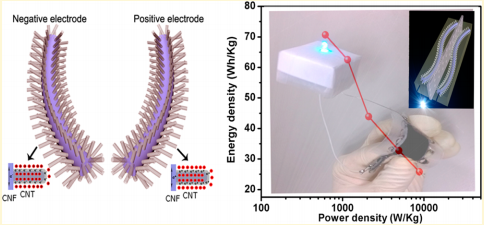With the development of modern science and technology, flexible, wearable, foldable, and smart electronic devices become ubiquitous, which calls for lighter, thinner, and tougher energy storage devices. Flexible supercapacitor has many virtues, such as high capacity, fast charge and discharge, safe, environmenttally friendly, and has a broad application prospect in the emerging smart electronic devices. Carbon textiles such as carbon cloth made of carbon fibers or carbon nanotube yarns have been widely used as flexible and binder-free electrodes to directly load various electrochemically active materials that exhibited good capacitance performance. However, most of the demonstrated devices based on the aqueous electrolyte have a low discharge voltage (<2 V), leading to low energy output and limited practical application.
Recently, ZHANG Yuegang’s group at the Suzhou Institute of Nano-Tech and Nano-Bionics, Chinese Academy of Sciences, used electrospinning and pyrolysis methods to prepare a hierarchical three-dimensional structure with vertically aligned carbon nanotubes directly grown on carbon nanobers (VACNTs/CNFs), and investigated its electrochemical performances. The VACNTs have significantly increased the CNF structure’s surface area, electronic conductivity, porosity, and electrolyte wettability. At the same time, the use of ionic liquid electrolyte could expand the electrochemical windows to 4V, which effectively improved the cell’s energy output. When using an ionic liquid electrolyte, the VACNTs/CNFs-based electric double layer (EDL) flexible supercapacitors can deliver a high specific energy of 70.7 Wh/kg at a current density of 0.5 A/g and at 30 °C, and an ultrahigh-energy density of 98.8 Wh/kg at a current density of 1.0 A/g and at 60 °C. Even after 20,000 charging/discharging cycles, the EDL capacitor still retains 97.0% of the initial capacitance. The excellent performance highlights the important role of the branched VACNTs in storing and accumulating charges and the CNF backbone in transporting charges, thereby boosting both power density and energy density. The results was published on Chemistry of Materials as a cover communication article (DOI: 10.1021/cm 503784x).
This synthetic method of 3D VACNTs/CNFs used flexible carbon fiber substrates instead of solid substrates such as silicon and metal plates. In addition, using PVP as carbon source could avoid using flammable gases, such as methane and ethylene, which makes this synthetic method low-cost, safe, and suitable for large-scale production to meet the demand of the emerging flexible energy storage devices.
This work was supported by the National Natural Science Foundation of China, China Postdoctoral Science Foundation, and the Natural Science Foundation of Jiangsu Province, China.

Figure: Schematic diagram of the VACNTs/CNFs structure (Left). Photograph of a bended VACNTs/CNFs-based flexible EDL capacitor and a lighted LED indicator (Right).(Image by SINANO)

